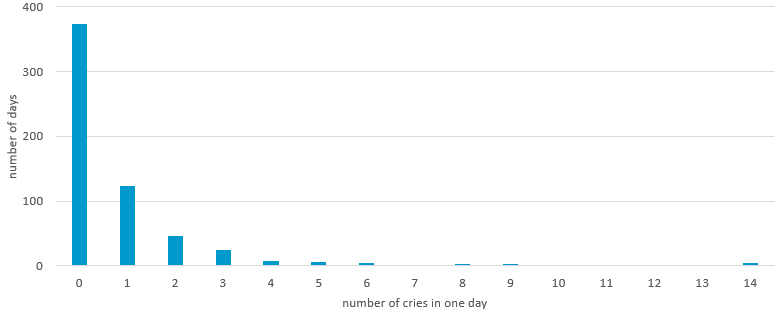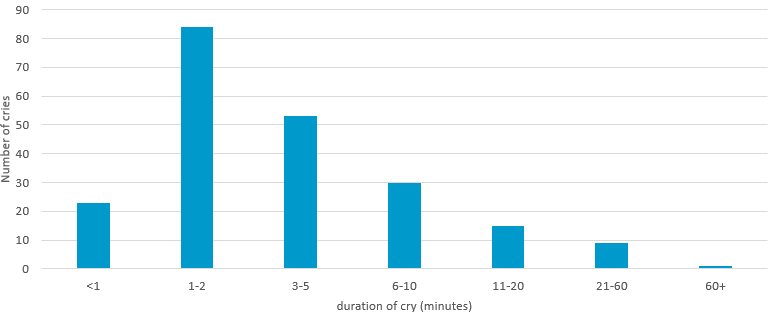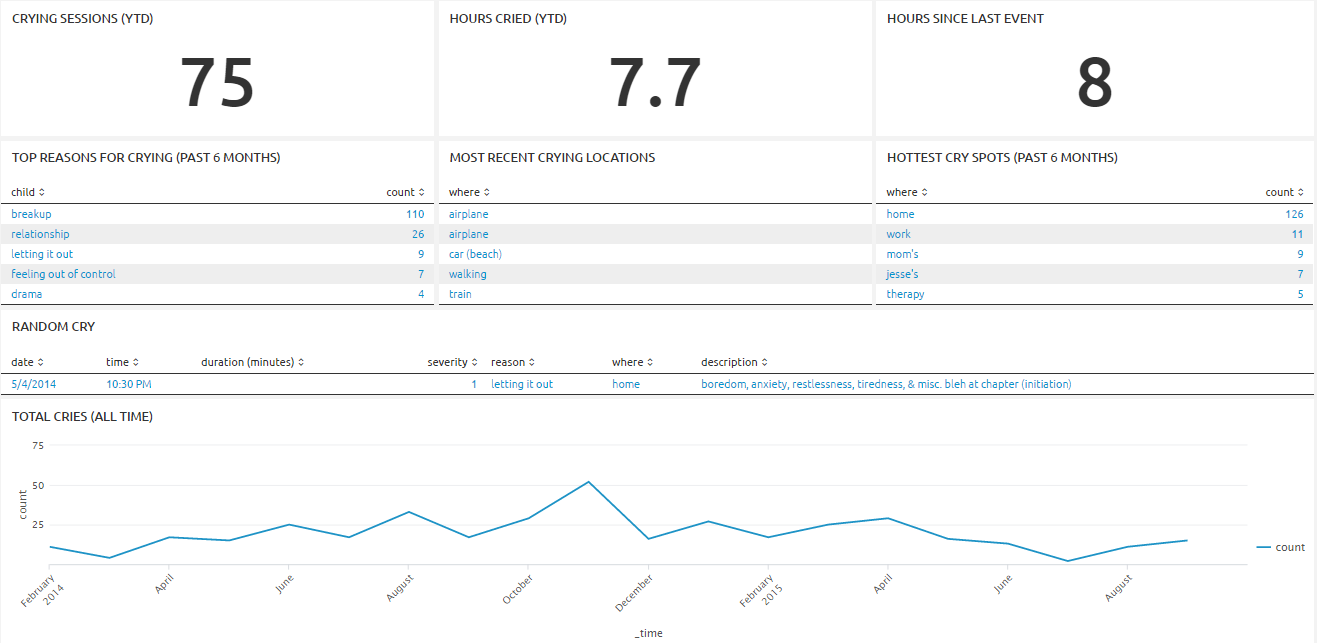Crying
May 11, 2016
Not all cries are made equal. Some consist of a stray melancholic tear, and some consist of unstoppable laughter. Some represent the deep, achy detachment of a piece of your identity, and some can only be onset by too much hot pepper. Whatever the provocation, as soon as any emotion or sensation crosses some intensity threshold, it seems to manifest itself by physically leaking out of one's eyes. And if that wasn't strange enough, the thresholds appear to be drastically different across people and stimuli. What in the actual what?I've always considered myself to be a bit of a crybaby, triggered frequently and privately and sometimes for hardly any reason at all. I've also always considered myself to be a fairly strong person, stable and resilient and able to work through challenging situations. I found it difficult to reconcile that part of myself with my overwhelming sensitivity, and I wondered about the exact nature of the things that were capable of pushing me over the edge. Naturally, I turned to spreadsheets to help me find the answers to my curiosities.

In order to track crying, I had to create a scheme to operationalize it. I defined a "cry" to begin once I shed a tear and to end when I regained composure. I also knew that my crying sessions varied highly by intensity, so I created a 1-5 scale to approximate the experience:
- I shed a tear or two.
- Water works, but I'm alright.
- My makeup's a mess* but my body's composed.
- I can't pretend to be okay anymore because my respiratory system doesn't work right.
- I am a crumpled pile of flesh and the rest of the world is suspended in my anguish.
I was definitely more interested in emotional rather than sensational stimuli, so I chose to exclude things like crying from pain or allergies or laughter but include things like feeling miserable or scared when plagued with the stomach flu.
Every time I cried for one of the "approved" reasons, I recorded the date, time, intensity, location, and situational or emotional context. Later on, I began tracking the duration of each cry, too. Here's what the spreadsheet looked like:

The data spans 589 days, beginning February 20, 2014 and ending October 1, 2015. Let's take a look at all that blubbering.
Number of cries per day

I cried a whopping 394 times on 216 unique days, which means that, on average, one out of every three days was a crying day, during which I cried two times. In reality, I usually cried once on any given day that I cried at all, but the distribution is pretty skewed. Here's what it looks like:
Distribution of number of cries per day

The longest I went without crying was 23 days. The most consecutive days I cried was 8. The average cry lasted 5 minutes and 50 seconds, but there was a long tail on the distribution:
Distribution of duration of cries

All in all, I cried for an estimated total of 38 hours, or about 2 hours per month. And in case you were wondering which days/hours I cried the most, here's a heat map:

I managed to cry during all hours of the day, but especially on Tuesdays, which is when I had therapy. (The high concentration of cries on Monday evenings was a bit of an anomaly).
I was completely and utterly alone 52.5% of the time I cried. I cried openly in front of someone 21% of the time, and I tried to hide the fact that I was crying in front of someone an additional 8% of the time. During the final 18.5% of cries, I was anonymous and alone in public.
54% of cries took place in my own home, but these are some other crying hotspots I frequented:
Popular crying locations

I also managed to cry onstage, at a laundromat, and in a McDonald's bathroom.
Intensity distribution

62% of my cries had an intensity of 1 or 2, which meant they were pretty casual and not all that disruptive to my day. 25% of my cries had an intensity of 3, which are somewhat taxing cries, but not always remarkable. Cries with intensities of 4 or 5 are practically an event - they cross the "not okay" threshold where my voice and breathing and energy are affected. There were fifty or so cries in the 4-5 range, which is... not a negligible amount.
So, why all the crying? I thought you'd never ask! It took me one failed card-sorting exercise and another grueling month-long endeavor, but I managed to sort each cry into one of 8 general categories, 28 situational contexts within a category, and 44 unique emotions that were underlying each cry.
The ??? category represents the less than 2% of cries that I couldn't interpret based on my notes about them.
Breakups and relationships were the root of 63% of the total cries. The data spanned the majority of a year-long, long-distance relationship, the entirety of a breakup, a little bit of dating, and the very beginning of another relationship. The breakup was a terrible mess during which I found out that my ex was actually married, and the lies and trauma caused 40% of my total crying.
Friend-related cries (5.5%) were caused by a handful of high-intensity situations: conflicts, weddings, recklessness, and life chats. It's satisfyingly straightforward.
Interacting with or thinking about my dearly beloved family caused 13% of my cries. A lot of that angst was related to planning, which we suck at, and the general "business of being family." A fair portion of cries was also related to mental and physical illness. Cries related to my family had the highest emotional complexity (number of cries divided by the number of emotions corresponding to that category).
A couple of my colleagues were disheartened to see that work made me cry, but only 2% of the time. What's more, 2/3 of the "work" cries were actually related to personal projects, not my actual job.
Life-related cries were essentially a formality of existing in a society. Planning, decision-making, responsibility-taking, traveling, illness, or plainly having a bad day. They were responsible for 20% of my crying and occurred almost exclusively when I was on a 10 week solo-travel trip around Europe, where there were constantly high levels of stress and overwhelm.
Lastly, reflection cries accounted for 8.5% of the data. Retrospection involved re-categorizing things that happened to me and re-evaluating past actions and decisions, which led me to feel ashamed, slighted, or self-pitying (I became a feminist during the time I was logging, and I reacted strongly to injustices that I became aware of). Introspection that led to crying involved self-criticism and questions about identity, which made me feel uncertain, dissonant, broken, ashamed, and inadequate.
Breakups and relationships were the root of 63% of the total cries. The data spanned the majority of a year-long, long-distance relationship, the entirety of a breakup, a little bit of dating, and the very beginning of another relationship. The breakup was a terrible mess during which I found out that my ex was actually married, and the lies and trauma caused 40% of my total crying.
Friend-related cries (5.5%) were caused by a handful of high-intensity situations: conflicts, weddings, recklessness, and life chats. It's satisfyingly straightforward.
Interacting with or thinking about my dearly beloved family caused 13% of my cries. A lot of that angst was related to planning, which we suck at, and the general "business of being family." A fair portion of cries was also related to mental and physical illness. Cries related to my family had the highest emotional complexity (number of cries divided by the number of emotions corresponding to that category).
A couple of my colleagues were disheartened to see that work made me cry, but only 2% of the time. What's more, 2/3 of the "work" cries were actually related to personal projects, not my actual job.
Life-related cries were essentially a formality of existing in a society. Planning, decision-making, responsibility-taking, traveling, illness, or plainly having a bad day. They were responsible for 20% of my crying and occurred almost exclusively when I was on a 10 week solo-travel trip around Europe, where there were constantly high levels of stress and overwhelm.
Lastly, reflection cries accounted for 8.5% of the data. Retrospection involved re-categorizing things that happened to me and re-evaluating past actions and decisions, which led me to feel ashamed, slighted, or self-pitying (I became a feminist during the time I was logging, and I reacted strongly to injustices that I became aware of). Introspection that led to crying involved self-criticism and questions about identity, which made me feel uncertain, dissonant, broken, ashamed, and inadequate.
Categories of cries over time

Looking at how the frequency of cries in each category changes over time shows us a few interesting things:
- Visual evidence that most of my life-related cries occurred during the summer I was traveling.
- The cyclical pattern of relationship- and breakup-related cries.
- The large gap in reflection-related cries until breakup-related cries fizzled; perhaps I lacked the energy to think about myself while I was processing my dismay and outrage at someone else.
Frequency of emotions

The most frequent emotions are fairly general (sad, hurt, angry), and the least frequent ones tend to be very particular (violated, bitter, scared, humbled). Many, but not all, of the emotions are negative or unpleasant, and they cover a broad range of activation - the amount of energy, adrenaline, liveliness, etc. you feel when you're experiencing something.
Emotions by average intensity

The emotions that led to the most intense cries tended to be unpleasant, high-activation, and fairly specific. The emotions that led to less intense cries were either pleasant or low-activation. It makes sense that "defeated" is more intense than "worn-down," that "miserable" is more intense than "sad," that "apoplectic" is more intense than "angry."
IN CONCLUSION
I cry a million times a year for a million different reasons in front of a million different people, but I also learned a lot from it.Positive ways that logging affected my life:
- I decided that it's not that big of a deal to cry in front of other people, so I'm way more open about my feelings now. I still worry about making other people uncomfortable, but I try very purposefully not to brush off my own feelings out of fear of vulnerability or embarrassment.
- I am more self-aware when I'm upset about something, and I am slightly more able to articulate my emotions as I am feeling them.
- I realized that the sorts things that make me cry change over time, because I either adapt to the situation or learn how to change it. For example, when I started logging, I cried a lot because planning things with my family felt stressful. Planning with my family still feels stressful, but I learned to manage the situation by 1) being more proactive about planning (instead of being upset that others aren't) and 2) changing my expectations when I don't feel like being proactive.
- I Pavlov's dogged myself: it became a compulsion to check the time every time I started (and stopped) crying, which I kind of think is funny, but also not.
- Logging took me out of the moment and introduced a layer of distance via analysis when I probably should have just been feeling my feels. This became especially problematic towards the end of the project, when I tried to categorize cries as they were happening (because I wanted to create a real-time crying dashboard), and when I started logging cries with an intensity of 0 (times that I was at the brink of crying, but didn't). I was basically exploiting my own emotions, which was not a great thing.

This is what the dashboard would've looked like. So cool.
It was fascinating (and excruciatingly difficult) to look back on all this data, but it was well worth the analysis, and I found myself wishing that I had more data from different times in my life. That being said, I will probably never log crying again.
If you have any questions about how I defined or distinguished emotions, or really about anything at all, please email me at [email protected]. Thank you for reading!